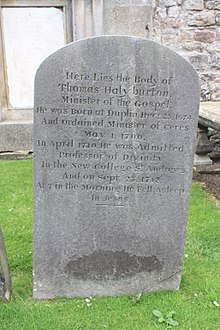Thomas Halyburton
Thomas Halyburton | |
|---|---|
 Engraving of Halyburton by John Scott | |
| Personal details | |
| Born | 25 December 1674 |
| Died | September 23, 1712 (aged 37) |

St Andrews Cathedral churchyard
Rev Prof Thomas Halyburton (25 December 1674 – 23 September 1712) was a Scottish divine. Thomas was educated there at Erasmus's school, in Rotterdam, where his mother had taken him to avoid persecution. He returned to Scotland in 1682, graduated at the university of St. Andrews 24 July, 1696 and, after serving as a private chaplain, was licensed by the presbytery of Kirkaldy 22 June 1699. He was ordained to the parish of Ceres, Fifeshire, 1 May 1700, but he injured his health by excessive labour. On 1 April 1710 he was appointed by Queen Anne, at the instance of the synod of Fife, professor of divinity at St. Mary's. He devoted his inaugural lecture to an attempt to confute the deistical views lately promulgated by Dr. Archibald Pitcairn in 1688. He died at St. Andrews 23 September 1712, aged only 38.[1]
Life[edit]
Thomas Halyburton was born at Duplin, near Perth on Christmas Day 1674. His father, Rev. George Halyburton, had been a minister in the Church of Scotland but was ejected for adherence to the principles of the Covenanters.[2] In 1676 the Privy Council of Scotland denounced the former minister for holding conventicles (church services in the open air, unauthorised by the established church and outlawed by the government). George died that same year, and in 1685 his wife moved the family to Rotterdam to avoid the fierce persecution which was carried out against the Covenanters.[3]
In Rotterdam young Thomas was educated in the school founded by Erasmus. Following the Glorious Revolution, he returned to Scotland and continued his education in Edinburgh.[2]
After a period of inner struggle with the philosophy of Deism, Halyburton returned to the faith of his father. On completing theological training, Halyburton graduated from the University of St Andrews with an MA on 24 July 1696.[4] He was licensed to preach in the Church of Scotland by Queen Anne, and ordained to the ministry of the church in Ceres, Fife in 1700. The church was part of the presbytery of Kirkcaldy.
After serving the church in Ceres for ten years, Halyburton was recommended by the synod of Fife for the position of Professor of Divinity at St Mary's College, St Andrews.[3]
He died two years later at the age of 37, following an illness. His body was buried in St Andrews Cathedral next to Rev. Dr. Samuel Rutherford.[3]
Legacy[edit]
Thomas Halyburton's theological and apologetic writings are marked by a distinctive thoroughness. The surviving scripts of his sermons show him to have been richly theological, deeply experimental (i.e. dealing with the experiences of the soul) and very practical—a master of the classic Puritan style of preaching.[5]
The extant writings of Rev. Thomas Halyburton were all published after his death:
- Natural Religion Insufficient, and Revealed Religion Necessary, to Man's Happiness in his Present State (1714), an able statement of the orthodox Calvinistic criticism of the deism of Lord Herbert of Cherbury and Charles Blount
- Memoirs of the Life of Mr Thomas Halyburton (1715), three parts by his own hand, the fourth from his diary by another hand
- The Great Concern of Salvation (1721), with a word of commendation by Isaac Watts
- Ten Sermons Preached Before and After the Lord's Supper (1722)
- The Unpardonable Sin Against the Holy Ghost (1784)[2]
John Wesley and George Whitefield were both influenced by Halyburton's writings.[4]
Family[edit]
He was married in 1701, to Janet Watson, and had issue —
- Margaret married William Wishart
- Elizabeth
- David
- George
- Janet
- Euphemia[4]
References[edit]
Citations[edit]
- ^ Lee 1890.
- ^ a b c Chisholm 1911.
- ^ a b c "Thomas Halyburton".
- ^ a b c Scott 1928.
- ^ James Begg Society, Thomas Halyburton
Sources[edit]
- Anderson, William (1877). "Halyburton, Thomas". The Scottish nation: or, The surnames, families, literature, honours, and biographical history of the people of Scotland. Vol. 2. A. Fullarton & co. pp. 414-415.
 This article incorporates text from this source, which is in the public domain.
This article incorporates text from this source, which is in the public domain. - Chambers, Robert (1870). Thomson, Thomas (ed.). A biographical dictionary of eminent Scotsmen. Vol. 2. London : Blackie and son. pp. 203-204.
- Halyburton, Thomas (1838). Memoirs of the Rev. Thomas Halyburton. Glasgow: William Collins.
- Halyburton, Thomas; Burns, Robert (1835). The works of the Rev. Thomas Halyburton : containing, The great concern of salvation, Treatise on natural and revealed religion, Communion sermons, and memoirs ; with an essay on his life and writings by the Rev. Robert Burns D. D. Paisley. London: Thomas Tegg.
- Lee, Sidney (1890). "Halyburton, Thomas". In Stephen, Leslie; Lee, Sidney (eds.). Dictionary of National Biography. Vol. 24. London: Smith, Elder & Co.
 This article incorporates text from this source, which is in the public domain.
This article incorporates text from this source, which is in the public domain. - Chisholm, Hugh, ed. (1911). "Halyburton, Thomas". Encyclopædia Britannica. Vol. 12 (11th ed.). Cambridge University Press. p. 867.
 This article incorporates text from this source, which is in the public domain.
This article incorporates text from this source, which is in the public domain. - Scott, Hew (1928). Fasti ecclesiae scoticanae; the succession of ministers in the Church of Scotland from the reformation. Vol. 7. Edinburgh: Oliver and Boyd. p. 429.
 This article incorporates text from this source, which is in the public domain.
This article incorporates text from this source, which is in the public domain.
External links[edit]
- Works by or about Thomas Halyburton at Internet Archive
- Works by Thomas Halyburton at Post-Reformation Digital Library
- Works by Thomas Halyburton at LibriVox (public domain audiobooks)

